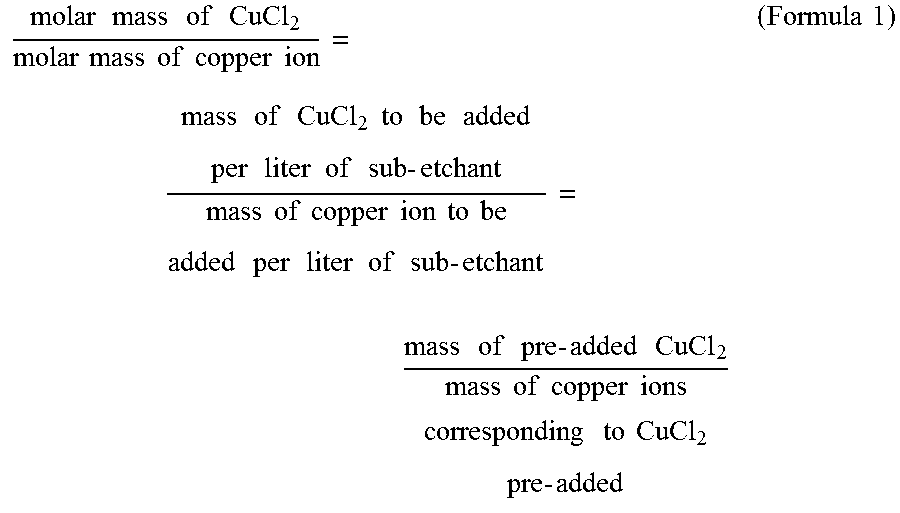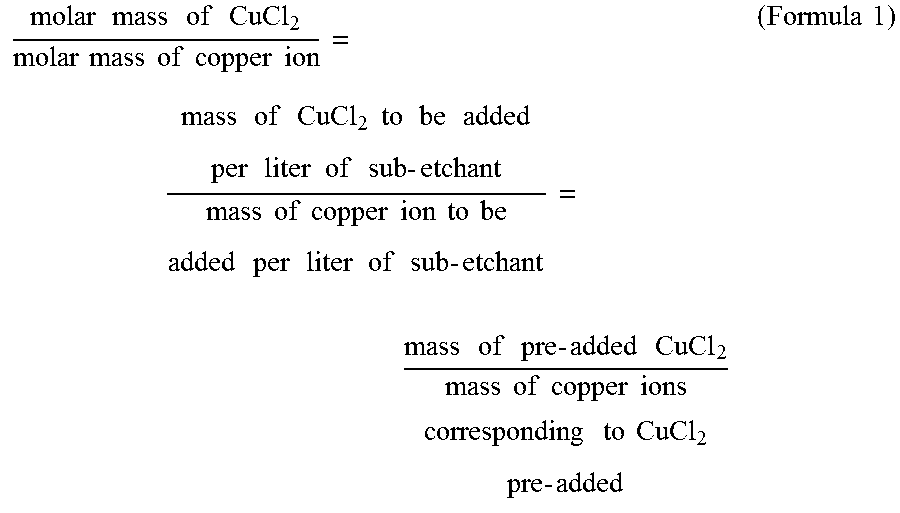High-efficiency High-quality and Safe Alkaline Cupric Chloride Etchant for Printed Circuit Board
a technology of alkaline cupric chloride and printed circuit board, which is applied in the manufacture of printed circuits, cable/conductor manufacturers, chemistry apparatuses and processes, etc., to achieve the effects of improving etching quality, high-efficiency high-quality, and reducing the amount of ammonium hydroxid
- Summary
- Abstract
- Description
- Claims
- Application Information
AI Technical Summary
Benefits of technology
Problems solved by technology
Method used
Image
Examples
embodiment 1
[0098]Binary control system was employed in the embodiment to control the amount of each component in the etchant.
[0099]Step 1: at ambient temperature and pressure, according to the designated components as illustrated in Table 1 below, selected raw materials are dissolved in water to prepare the sub-etchant; 25% ammonium hydroxide was prepared.
[0100]Step 2: cupric chloride was added into per litre of the sub-etchant obtained in step 1; the added amount of cupric chloride was obtained by calculation according to the set value of the concentration of copper ions in the solution listed in Table 1:
molarmassofCuCl2molarmassofcopperion=massofCuCl2tobeaddedperliterofsub-etchantmassofcopperiontobeaddedperliterofsub-etchant=massofpre-addedCuCl2massofcopperionscorrespondingtoCuCl2pre-added(Formula1)
[0101]Wherein the molar mass of cupric chloride is 134.5 g / mol; and the molar mass of copper ion is 63.5 g / mol. The mass of copper ion to be added into per litre of sub-etchant is 130 g according ...
embodiments 2-3
[0107]The procedures of embodiment 1 were repeated respectively, using the designated content of each component and parameters of the automatic detection and charging control machine as specified in embodiments 2-3 of Table 1 below. Wherein in step 2, 2 g of cupric chloride was first added into per litre of the sub-etchant obtained in step 1, and then copper was added to allow the concentration of copper ions in the obtained solution to reach the value specified in embodiments 2-3 of Table 1 (i.e. 130 g / L). According to formula 1 and formula 2 described in the background of the invention, the mass of copper added was 130−(2×63.5÷134.5)=129 g.
embodiments 4-10
[0108]The procedures of embodiment 1 were repeated respectively, using the designated content of each component and parameters of the automatic detection and charging control machine as specified in embodiments 4-10 of Table 1 below. Wherein in step 2, 254.2 g of cupric chloride was added into per litre of the sub-etchant obtained in step 1 to allow the concentration of copper ions in the obtained solution to reach the value specified in embodiments 4-10 of Table 1.
[0109]In embodiments 4-10, the composition of the sub-etchant, the concentration of copper ions, and the specific density of the automatic detection and charging control machine are identical but the pH values are different. It is shown from the results that as the pH of the etchant increases, the etching rate increases.
PUM
| Property | Measurement | Unit |
|---|---|---|
| concentration | aaaaa | aaaaa |
| concentration | aaaaa | aaaaa |
| temperature | aaaaa | aaaaa |
Abstract
Description
Claims
Application Information
 Login to View More
Login to View More - R&D
- Intellectual Property
- Life Sciences
- Materials
- Tech Scout
- Unparalleled Data Quality
- Higher Quality Content
- 60% Fewer Hallucinations
Browse by: Latest US Patents, China's latest patents, Technical Efficacy Thesaurus, Application Domain, Technology Topic, Popular Technical Reports.
© 2025 PatSnap. All rights reserved.Legal|Privacy policy|Modern Slavery Act Transparency Statement|Sitemap|About US| Contact US: help@patsnap.com



